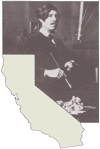![]()

Five Views: An Ethnic Historic Site Survey for California
MENU
Introduction
Mexican War
Post-Conquest
1900-1940
World War II
Chicano Movement
Future
Historic Sites
Selected References

A History of Mexican Americans in California:
HISTORIC SITES
St. Francis Dam Flood
Santa Paula, Ventura County
The San Francisquito Canyon, 50 miles west of Ventura, is a narrow gorge running roughly north and south which links the San Joaquin and Santa Clara Valleys. Here, in 1926, the St. Francis Dam was completed at a cost of $1.3 million. A link in California's growing aqueduct system designed to reroute the waters of the southern Sierra to Los Angeles, the St. Francis Dam and Reservoir im pounded water brought from the Owens Valley, and like the Owens Valley Aqueduct, was constructed under the personal supervision of Los Angeles' Chief Engineer, William Mulholland. At the time of its construction, the dam was hailed as a great accomplishment, but two years later its failure caused one of the worst disasters in California's history.
On March 11, 1928, the reservoir behind the St. Francis Dam held approximately 12 million gallons of water, or enough water to supply the city of Los Angeles for roughly two and a half months. When water began leaking around Powerhouse Two about one mile below the dam on March 12, the Los Angeles Bureau of Water and Power, the agency responsible for maintaining the dam, determined that there was no reason to evacuate any of the 20,000 people in the Santa Clara Valley. Twelve hours later, at midnight, the dam burst.
Although the mid-section of the dam remained standing, the sides collapsed and "were swept three-quarters of a mile downstream." (Cornell, p. 277) A wall of water 80 feet high, constrained by the narrow San Francisquito Canyon, gathered speed as it descended to the Santa Clara river bed, where it spread out to flood an area 60 miles wide. The water inundated Highway 126, along which some 50 cars and their estimated 125 passengers were traveling. "Eighty men in a construction camp immediately below the dam drowned, except for five men who were carried on their cots along the top of the wave as if riding on surfboards" (Ibid.) In all, at least a thousand people were left homeless by the flood and as many as 450 people died, although some estimates ranged as high as 700 dead.
The town of Santa Paula bore the brunt of the flood's fury. Unprepared, with no foreknowledge of the impending disaster, many were swept from their beds by the flood water which inundated the area at 3:30 a.m. Ten minutes later, the crest, still 30 feet high, hit the stricken community. Unlike the town of Saticoy which was only partially inundated, the flood caused at least a million dollars' damages in Santa Paula. To the relief of many in the town, most of the damage occurred in the Chicano barrio below Main Street.
Enticed by the availability of work in the citrus orchards around Santa Paula, the Chicano and Mexican community lived under a semifeudal system that provided them housing at reasonable rates but paid them practically nothing for their labor, and offered no possibility of advancement to either pickers or packing house employees. Although education was available (in segregated schools, of course), any form of advanced education that might have depleted the labor supply in the orchards was discouraged. As if such discrimination were not enough, Spanish-speaking inhabitants of Santa Paula were castigated the day after the town was inundated for their failure "to heed the warning of the coming flood." By supposedly refusing "to move out of the danger zone . . . many of them lost their lives...." (Ventura Free Press, March 13, 1928)
At least 61 people died in the flood at Santa Paula; 50 in Saticoy; 49 in Newhall; 47 in Fillmore; and 40 at Moorpark — staggering losses compared to the nine who died in Ventura and the four who lost their lives at Oxnard.
The collapse of the dam, which destroyed homes, buildings, bridges, railroads, livestock, farmland, and orchards along the 54-mile route covered by the water in less than 5-1/2 hours, was attributed by embarrassed officials to an earthquake tremor or to sabotage. But "later investigations proved the dam simply was unable to withstand the water pressure behind it." (Hart, p. 366; Cornell, p. 277) When the dam, which was 175 feet high and 175 feet wide at its base, was built, no tests were conducted to determine the stability of the valley's rock formations. Unfortunately for the dam's victims, "one end of the dam had been anchored in mica schist, a layered rock formation . . . and the center of the dam overlay a fault zone in which the rocks had once been reduced to powder and then recompressed." (Cornell, p. 276) Neither formation, however, could bear the weight of the water which had accumulated in the swollen reservoir. The resulting tragedy has to be attributed to the poor judgment of Los Angeles' Chief Engineer William Mulholland for building the dam without conducting an adequate survey of the underlying rock, and to the Los Angeles Bureau of Water and Power for failing to warn communities in the Santa Clara Valley on March 12, 1928 that the dam was leaking or that there were visible cracks in the outer surface of the dam, and that there was at least a possibility that the situation might become critical.
NEXT> St. Mary's Catholic Church
Last Modified: Wed, Nov 17 2004 10:00:00 pm PDT
http://www.cr.nps.gov/history/online_books/5views/5views5h89.htm
![]()
 Top
Top